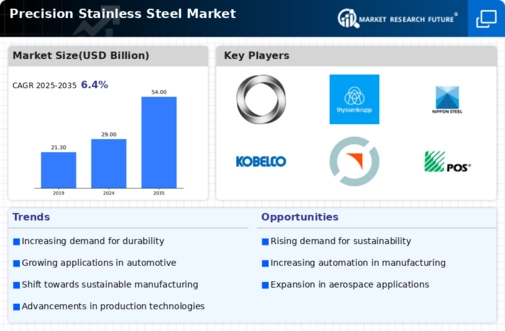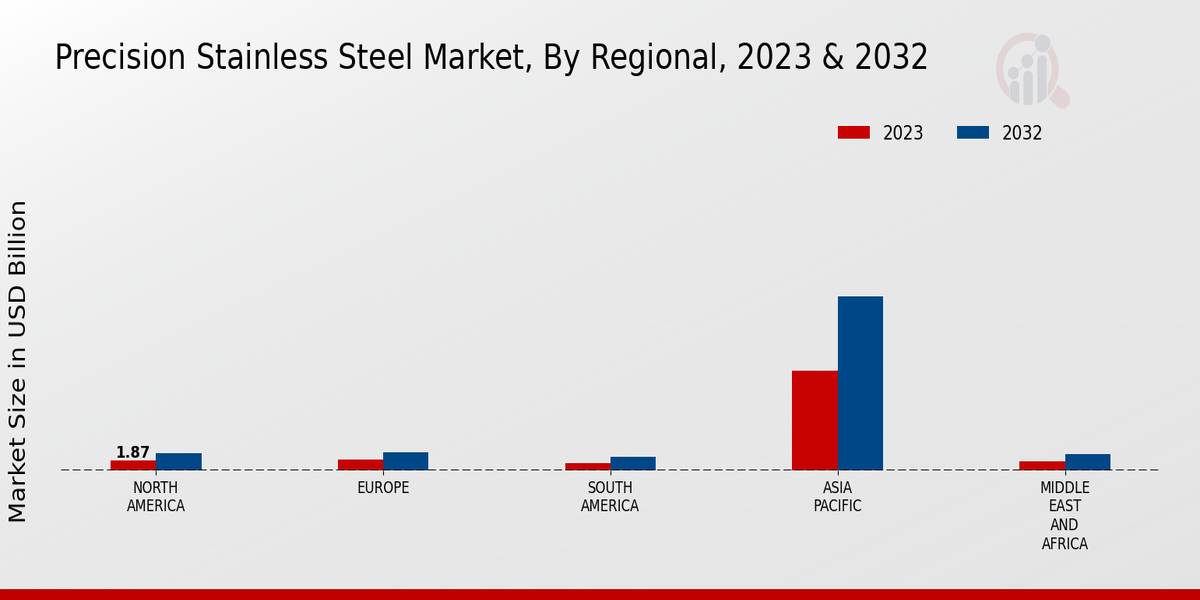Market Growth Projections
The Global Precision Stainless Steel Market Industry is on a trajectory of growth, with projections indicating a market size of 29.0 USD Billion in 2024 and an anticipated increase to 54.0 USD Billion by 2035. This growth is underpinned by a compound annual growth rate of 5.8% from 2025 to 2035, reflecting the material's expanding applications across various sectors. The increasing demand for high-performance materials in industries such as automotive, construction, and energy is likely to drive this growth. As manufacturers continue to innovate and adapt to market needs, the precision stainless steel market is expected to evolve, presenting opportunities for stakeholders across the supply chain.
Expansion of Energy Sector
The energy sector, particularly renewable energy, is driving demand for precision stainless steel due to its applications in solar panels, wind turbines, and other energy-efficient technologies. The material's durability and resistance to harsh environmental conditions make it suitable for these applications, which are crucial for achieving energy efficiency and sustainability goals. The Global Precision Stainless Steel Market Industry is expected to benefit from this trend, as investments in renewable energy infrastructure continue to rise. This sector's growth is anticipated to contribute to the market's expansion, with projections indicating a market size of 54.0 USD Billion by 2035, reflecting the increasing reliance on precision stainless steel in energy applications.
Growth in Construction Activities
The construction industry is witnessing a resurgence, leading to heightened demand for precision stainless steel in various applications, including structural frameworks and architectural elements. The material's resistance to corrosion and aesthetic appeal makes it a preferred choice for modern buildings and infrastructure projects. The Global Precision Stainless Steel Market Industry is poised to capitalize on this growth, as investments in urban development and infrastructure are projected to increase. This trend is expected to contribute to the market's expansion, with a compound annual growth rate of 5.8% anticipated from 2025 to 2035, reflecting the material's integral role in contemporary construction.
Increasing Focus on Sustainability
The growing emphasis on sustainability and environmental responsibility is influencing the Global Precision Stainless Steel Market Industry. Manufacturers are increasingly adopting eco-friendly practices, such as recycling and reducing waste during production. Precision stainless steel, known for its recyclability and longevity, aligns well with these sustainability goals, making it an attractive option for various industries. As consumers and businesses alike prioritize sustainable materials, the demand for precision stainless steel is likely to increase. This shift not only supports environmental initiatives but also positions the market for robust growth, as stakeholders seek to meet evolving regulatory standards and consumer preferences.
Rising Demand from Automotive Sector
The automotive sector is experiencing a notable increase in demand for precision stainless steel, driven by the need for lightweight and corrosion-resistant materials. This trend is particularly evident in the production of components such as exhaust systems and structural parts, which require high strength and durability. The Global Precision Stainless Steel Market Industry is projected to benefit significantly from this demand, with the market expected to reach 29.0 USD Billion in 2024. As automotive manufacturers increasingly prioritize sustainability and fuel efficiency, the adoption of precision stainless steel is likely to grow, contributing to the overall expansion of the market.
Technological Advancements in Manufacturing
Technological advancements in manufacturing processes are enhancing the production capabilities of precision stainless steel, leading to improved quality and efficiency. Innovations such as advanced welding techniques and automated production lines are enabling manufacturers to produce high-performance stainless steel products that meet stringent industry standards. This evolution is particularly relevant in the Global Precision Stainless Steel Market Industry, where precision and consistency are paramount. As manufacturers adopt these technologies, they are likely to achieve cost reductions and increased output, thereby positioning themselves favorably in a competitive landscape. This trend may further stimulate market growth as demand for high-quality stainless steel continues to rise.












